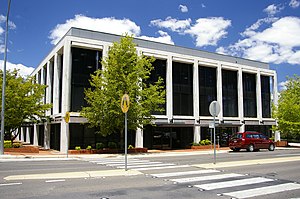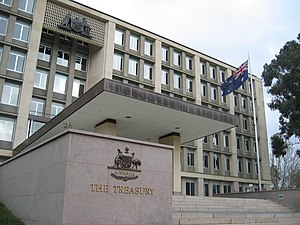 English: RBA sign (Photo credit: Wikipedia)
English: RBA sign (Photo credit: Wikipedia)A memo obtained by the ABC's 7.30 program shows that at least one senior official at the Reserve Bank knew of allegations that RBA subsidiary companies were involved in corruption prior to the allegations being made public.Eight former senior executives from two firms owned by the RBA are facing allegations that they paid tens of millions of dollars in bribes to win bank-note printing contracts overseas.
But a major part of this scandal has remained hidden until now, and it has never been the subject of any inquiry.
 English: Reserve Bank of Australia located on London Circuit in Canberra, Australian Capital Territory. (Photo credit: Wikipedia)
English: Reserve Bank of Australia located on London Circuit in Canberra, Australian Capital Territory. (Photo credit: Wikipedia)It concerns what top officials in the Reserve Bank itself knew about bribery and corruption inside the RBA's subsidiaries well before the scandal became public and police began their investigation in 2009.
Reserve Bank governor Glenn Stevens has told Parliament several times since then that the RBA was in the dark about corruption and bribery inside the firms Securency and Note Printing Australia (NPA) before the 2009 expose.
But 7.30 has obtained damning new evidence that contradicts those claims and is likely to reignite debate about whether the Federal Government needs to call a broad inquiry into the affair.
The memo reveals that former deputy governor Ric Battellino was advised of the alleged illegal behaviour at a meeting with a whistleblower in 2007.
 The allegations were then detailed in a five-page memo which was sent to Mr Battelino.
The allegations were then detailed in a five-page memo which was sent to Mr Battelino.Dr David Chaikin, a former adviser to the Attorney-General's department, said he would rate the memo as a "smoking gun" because of the nature of the warnings.
"For example, it was being stated that the company secretary heard first-hand from agents that they were making corrupt payments to politicians and political parties," he told 7.30.
"All these are clear warning signs of corruption and you don't need to be an expert to heed those warning signs."
Securency and NPA are alleged to have bribed foreign officials to help win contracts to print polymer bank notes in Malaysia and Nepal.
"This is not about individuals accused of corruption. This is about what the RBA knew about that corruption," Dr Chaikin said.
"It goes to the integrity of the most important financial body in Australia."
Secret meeting
In June 2007, two years before the scandal broke in the media, a secret meeting was held at the bank's head office in Martin Place in Sydney.Bank sources have revealed who was there: Mr Battellino and Brian Hood, who was the company secretary of NPA at the time.
At the Martin Place meeting, Mr Hood revealed he had serious concerns about probity issues, which had not been adequately addressed inside the RBA firm.
Six months ago, Mr Stevens was asked if the Reserve Bank was directly told of the probity concerns inside NPA.
"If you are asking whether the person in question wrote a letter or something to the bank, I do not think that he did, no," Mr Stevens said.
But in fact, shortly after the Martin Place meeting, Mr Hood set out his concerns in great detail in the memo addressed to Mr Battellino.
The memo, given to 7.30 by RBA sources, details what Mr Hood saw as corrupt behaviour involving NPA and "extraordinary" multi-million-dollar payments to its overseas agents.
Among the agents was Abdul Kayum, a Malaysian arms dealer who the memo revealed was working for both NPA and Securency.
The memo to Mr Battellino reveals the payments made by the RBA firm to its Malaysian agent had been used to make "payment to others - including officials... and politicians".
The agent had said that "dealing through such networks was the accepted way of doing business in that part of the world".
The same agent had asked for "commission funds owing to him to be directed to an ANZ Brisbane account" but would "not explain what position/role the nominated individual had".
The memo documents similar concerns about commissions paid to agents in Nepal.
Mr Hood reported that the Nepali agent had "complained there was little left for him after servicing others", apparently because the Nepali "agent made donations to political parties".
The memo also reveals NPA had deliberately misled the Nepal Central Bank about how much it was paying its agent there.
'Out of control'
7.30 showed the Hood memo to former United Nations corruption fighter Howard Whitton, who says it revealed an "extraordinary way of doing business"."The core message was that this organisation is out of control, we are doing bad things or illegal things in other countries and we are covering it up," he said.
Mr Hood reported to Mr Battellino that when he had earlier raised bribery concerns inside NPA, he was warned by the firm's managing director Chris Ogilvy - who was also a Securency director - to "back off".
Mr Whitton says the RBA should have immediately involved the police.
"No question at all. They have clear evidence from a responsible official who has a legal duty to advise the RBA as the parent of Note Printing Australia that corrupt conduct, criminal conduct was happening on their watch, and it seems to me that it is obvious the AFP should have been called in at that point," he said.
Dr Chaikin agrees the police should have been called in.
"I think the most striking thing is the company secretary was pleading to the Reserve Bank for assistance," he said.
"He and the rest of the Australian community has been let down by what has happened."
About face
The RBA did not call in the Federal Police. They did seek advice from a corporate law firm.NPA's foreign agents were quietly sacked in 2007 and soon after some of NPA's senior mangers - including Mr Hood - were pushed out. It would take months for Federal Police agents to discover the Hood memo after their inquiry began in May 2009.
Almost two years later, Mr Stevens told Parliament's economics committee nothing about the Hood memo. Mr Battellino was sitting next to Mr Stevens at the time.
"We are examining ourselves. A question would be: is there any way that anyone in the RBA ever knew anything about anything? I am pretty sure the answer to that is no," Mr Stevens said at the time.
Earlier this year, two weeks after Mr Battellino retired from the RBA, Mr Stevens changed his story.
"I think I said that the bank was aware of that but that it was not in writing. Actually, that was not quite true," he said.
"I have been reminded while we have been talking that, in fact, the deputy governor invited that person to put that in writing, which he did, and give it to the deputy governor."
Mr Stevens and Mr Battellino declined 7.30's requests for an interview.
7.30 received a statement from the Reserve Bank which referred to action taken by Note Printing Australia on the corruption allegations.
But that statement does not address the issue of what the bank itself knew.
Read the RBA response below.
Images from Wikipedia - because I have none of the RBA.

No comments:
Post a Comment